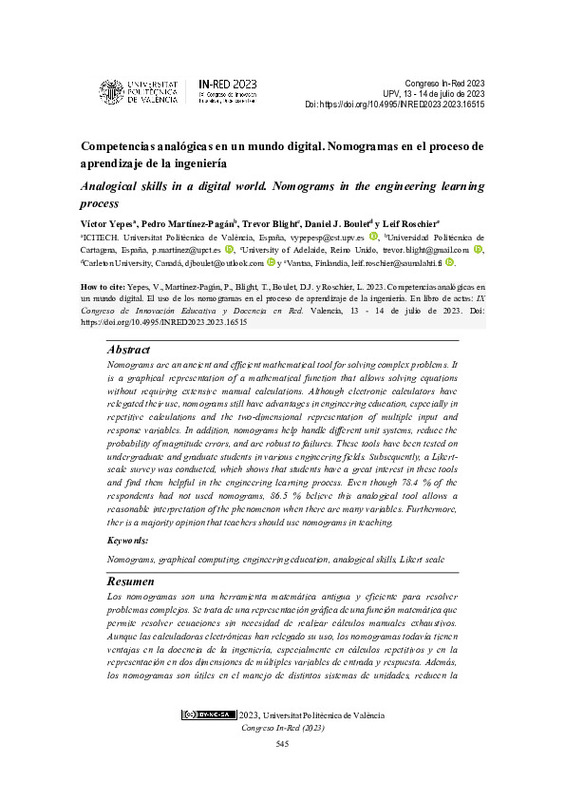JavaScript is disabled for your browser. Some features of this site may not work without it.
Buscar en RiuNet
Listar
Mi cuenta
Estadísticas
Ayuda RiuNet
Admin. UPV
Competencias analógicas en un mundo digital. Nomogramas en el proceso de aprendizaje de la ingeniería
Mostrar el registro sencillo del ítem
Ficheros en el ítem
| dc.contributor.author | Yepes, Víctor
|
es_ES |
| dc.contributor.author | Martínez-Pagán, Pedro
|
es_ES |
| dc.contributor.author | Blight, Trevor
|
es_ES |
| dc.contributor.author | Boulet, Daniel
|
es_ES |
| dc.contributor.author | Roschier, Leif
|
es_ES |
| dc.date.accessioned | 2023-12-12T13:01:36Z | |
| dc.date.available | 2023-12-12T13:01:36Z | |
| dc.date.issued | 2023-10-06 | |
| dc.identifier.isbn | 9788413960883 | |
| dc.identifier.uri | http://hdl.handle.net/10251/200648 | |
| dc.description.abstract | [EN] Nomograms are an ancient and efficient mathematical tool for solving complex problems. It is a graphical representation of a mathematical function that allows solving equations without requiring extensive manual calculations. Although electronic calculators have relegated their use, nomograms still have advantages in engineering education, especially in repetitive calculations and the two-dimensional representation of multiple input and response variables. In addition, nomograms help handle different unit systems, reduce the probability of magnitude errors, and are robust to failures. These tools have been tested on undergraduate and graduate students in various engineering fields. Subsequently, a Likertscale survey was conducted, which shows that students have a great interest in these tools and find them helpful in the engineering learning process. Even though 78.4 % of the respondents had not used nomograms, 86.5 % believe this analogical tool allows a reasonable interpretation of the phenomenon when there are many variables. Furthermore, ther is a majority opinion that teachers should use nomograms in teaching. | es_ES |
| dc.description.abstract | [ES] Los nomogramas son una herramienta matemática antigua y eficiente para resolver problemas complejos. Se trata de una representación gráfica de una función matemática que permite resolver ecuaciones sin necesidad de realizar cálculos manuales exhaustivos. Aunque las calculadoras electrónicas han relegado su uso, los nomogramas todavía tienen ventajas en la docencia de la ingeniería, especialmente en cálculos repetitivos y en la representación en dos dimensiones de múltiples variables de entrada y respuesta. Además, los nomogramas son útiles en el manejo de distintos sistemas de unidades, reducen la probabilidad de errores de magnitud y son robustos a fallos. Se ha probado el uso de estas herramientas en estudiantes de grado y posgrado en diversas ingenierías. Posteriormente, se realizó una encuesta en escala Likert que demuestra que los estudiantes tienen un gran interés en estas herramientas y encuentran que son útiles en el proceso de aprendizaje de la ingeniería. A pesar de que un 78,4 % de los encuestados no habían utilizado nomogramas, el 86,5 % cree que esta herramienta analógica permite una buena interpretación del fenómeno cuando hay muchas variables y que los profesores deberían utilizarla en la docencia. | es_ES |
| dc.description.sponsorship | Apoyo recibido por el Ministerio de Ciencia e Innovación (Proyecto de Investigación PID2020-117056RB-I00). | es_ES |
| dc.format.extent | 14 | es_ES |
| dc.language | Español | es_ES |
| dc.publisher | Editorial Universitat Politècnica de València | es_ES |
| dc.relation.ispartof | In-Red 2023 - IX Congreso Nacional de Innovación Educativa y Docencia en Red | |
| dc.rights | Reconocimiento - No comercial - Compartir igual (by-nc-sa) | es_ES |
| dc.subject | Nomogramas | es_ES |
| dc.subject | Cálculo gráfico | es_ES |
| dc.subject | Enseñanza de la ingeniería | es_ES |
| dc.subject | Competencias analógicas | es_ES |
| dc.subject | Escala Likert | es_ES |
| dc.subject | Nomograms | es_ES |
| dc.subject | Graphical computing | es_ES |
| dc.subject | Engineering education | es_ES |
| dc.subject | Analogical skills | es_ES |
| dc.subject | Likert scale | es_ES |
| dc.title | Competencias analógicas en un mundo digital. Nomogramas en el proceso de aprendizaje de la ingeniería | es_ES |
| dc.title.alternative | Analogical skills in a digital world. Nomograms in the engineering learning process | es_ES |
| dc.type | Capítulo de libro | es_ES |
| dc.type | Comunicación en congreso | es_ES |
| dc.identifier.doi | 10.4995/INRED2023.2023.16515 | |
| dc.relation.projectID | info:eu-repo/grantAgreement/AEI/Plan Estatal de Investigación Científica y Técnica y de Innovación 2017-2020/PID2020-117056RB-I00/ES/OPTIMIZACION HIBRIDA DEL CICLO DE VIDA DE PUENTES Y ESTRUCTURAS MIXTAS Y MODULARES DE ALTA EFICIENCIA SOCIAL Y MEDIOAMBIENTAL BAJO PRESUPUESTOS RESTRICTIVOS/ | es_ES |
| dc.rights.accessRights | Abierto | es_ES |
| dc.description.bibliographicCitation | Yepes, V.; Martínez-Pagán, P.; Blight, T.; Boulet, D.; Roschier, L. (2023). Competencias analógicas en un mundo digital. Nomogramas en el proceso de aprendizaje de la ingeniería. Editorial Universitat Politècnica de València. 545-558. https://doi.org/10.4995/INRED2023.2023.16515 | es_ES |
| dc.description.accrualMethod | OCS | es_ES |
| dc.relation.conferencename | IN-RED 2023: IX Congreso de Innovación Educativa y Docencia en Red | es_ES |
| dc.relation.conferencedate | Julio 13-14, 2023 | es_ES |
| dc.relation.conferenceplace | Valencia, España | es_ES |
| dc.relation.publisherversion | http://ocs.editorial.upv.es/index.php/INRED/INRED2023/paper/view/16515 | es_ES |
| dc.description.upvformatpinicio | 545 | es_ES |
| dc.description.upvformatpfin | 558 | es_ES |
| dc.type.version | info:eu-repo/semantics/publishedVersion | es_ES |
| dc.relation.pasarela | OCS\16515 | es_ES |
| dc.contributor.funder | Agencia Estatal de Investigación | es_ES |








